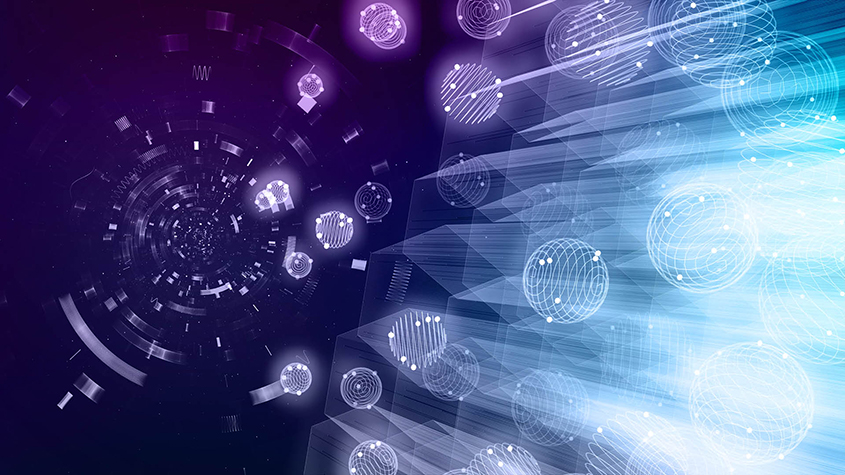James Nurton氏、フリーランス・ライター

Inference Engine (SHINE) が最初に実力を発揮したのは、宇宙船ボイ
ジャーが1989年に海王星に接近する直前に、遠隔測定システムの
異常を発見したときのことでした。以来、このソフトウェアはNASA
の多くのシステムの状態を監視するために使用されています。
(写真: NASA提供)
NASAの定評ある技術移転プログラムは、スタートアップを含む起業家を幅広く支援するために提供され、自転車や医療機器などの製品を変革する最先端の発明を実現しています。
米国のスタートアップ企業The SMART Tire Companyは、2022年にマウンテンバイク用の全く新しいタイヤの発売を予定しています。METLと名付けられたこのタイヤは、ニッケルチタン合金製の超弾性エアレス・タイヤです。一般的なゴム製タイヤに比べて非常に耐久性が高く、パンクせず、廃棄物の大幅削減につながります。
しかし、METLタイヤに使われている技術は、タイヤメーカーや自動車メーカーで生まれたものではありません。このタイヤは、クリーブランドにある米航空宇宙局 (NASA) のグレン研究センターで開発されました。非空気入りタイヤという発想は、1960年代の月面探査車に遡ります。その後開発は続けられ、2026年に火星に向かうフェッチ・ローバーでも使用される予定です。
NASAはSMART (shape memory alloy radial technology) と呼ばれる形状記憶合金ラジアル技術が地球上の車両でも使えることを知り、ライセンスが取得できるようにしました。2020年、The SMART Tire Companyの設立者であるBrian Yennie氏とEarl Cole氏はNASAのStartup Studioプログラムに参加し、自転車用タイヤを製造するためにNASAの特許のライセンスを取得しました。ワシントンDCにあるNASA本部の技術移転プログラム (Technology Transfer Program) 担当エグゼクティブDaniel Lockney氏は「これは技術の素晴らしい進化です」と言います。「同社はオハイオ州アクロンに移転し、事業のさらなる拡大を計画しています。」
1958年国家航空宇宙法は、科学および工学の発展はすべて公共の利益のために利用されるようにしなければならないと規定しています。
ゴダード宇宙飛行センター、技術移転局 (Technology Transfer Office) 責任者、Darryl Mitchell氏
それは宇宙からやってきた
技術移転は、NASA設立当初からのミッションの中核をなすものです。ゴダード宇宙飛行センターの技術移転局 (Technology Transfer Office) 責任者、Darryl Mitchell氏は、「1958年国家航空宇宙法は、科学および工学の発展はすべて公共の利益のために利用されるようにしなければならないと規定しています」と語ります。現在NASAは10のフィールドセンターで大規模な技術移転プログラムを実施しており、同氏は次のように述べています。「このプログラムは、NASAに対する支持を築き、雇用を創出し、一部技術の将来のパイプラインを作り出します。」
総勢11,000人の科学者とエンジニアを擁するNASAは、世界でも特に多くのイノベーションを生み出しています。技術移転プログラムには、毎年さまざまな用途を持つ約1,600の技術が追加されています。Mitchell氏によると、例えばゴダード宇宙飛行センターでは、センサーや探知器に関する多くの研究が行われており、後に医療診断分野に移転される可能性があります。

米国の連邦政府機関の中で、自らの知財ポートフォリオ全体の詳細を単体の検索可能なウェブポータル上で公開しているのはNASAだけです。有効特許は約1,500件で、うち約1,100件はライセンス供与が可能です (残りも、独占契約でほぼライセンス供与されます) 。2021年度には、過去最高となる200件を超える特許ライセンス契約を締結しました。
Lockney氏は、2011年にプログラムの責任者に就任しました。同氏が取り組んだことの1つが、10のフィールドセンターにおける技術移転の方針とプロセスを簡略化し、標準化することでした。この実現を支援するために、NASAはNASA Technology Transfer Systemツールを開発しました。このツールは、発明に関する複数ステップのプロセスで構成され、発明者への詳細なインタビューと評価 (潜在的な用途に関して業界にアウトリーチする場合があります) という2つの独立した審査が行われます。このプロセスが無事完了して初めて、特許出願を申請します。
結果的に、NASAのイノベーション活動の規模に対して少数の特許 (年間約80件) を出願しています。「NASAは、防御目的や名声を得るためではなく、商用化のみを目的として特許を出願します」とLockney氏は言います。「もしライセンシーがいなければ手放します。」
NASAで生まれた技術
携帯電話用カメラ: スマートフォンに搭載されているデジタルカメラは、1965年にNASAの科学者Eugene Lally氏が開発したセンサーがもとになっています。このセンサーは光子を電子に変換して画像に変えます。この技術はもともと衛星で利用されていましたが、のちにノキア (Nokia) や他の電話機メーカーにライセンス供与されました。
サングラス: 紫外線を遮断するガラスは、宇宙空間および地球上で閃光やレーザー、溶接の光からNASAの作業員を保護するために開発されました。
人工呼吸器: 新型コロナウイルスのパンデミックが発生すると、NASAのジェット推進研究所のエンジニアたちがVentilator Intervention Technology Accessible Locally (VITAL) と呼ばれる人工呼吸器を開発しました。プロトタイプはわずか37日で完成しました。NASAはブラジル、インドなどの36を超える企業にライセンスを無償提供しています。

スタートアップ向けのライセンシング
NASAのフィールドセンター全体で技術移転プロセスを標準化する最近の取り組みの中で、最も成功を収めているのがNASA Startup Licenseです。Startup Licenseは、NASAのウェブサイトで申請できる3種類のライセンスの1つです (他の2つはStandard Commercial LicenseとEvaluation License)。
標準的なStartup Licenseは、NASA技術の商業化を目指す企業が非独占契約で利用できます。初期費用は不要で、最初の3年間は最低使用料もかかりません。製品の販売を開始すると、通常4.2%のロイヤリティが発生します。
過去5年間にStartup Licenseプログラムで100社を超える米国のスタートアップ企業が特許のライセンスを取得しました。しかし、このプログラムのメリットは他にもあるとMitchell氏は言います。「Startup Licenseの要件を満たしていない企業ともNASAは取引できます。プログラム全体の目的は、ライセンシング・プロセスを迅速化し、小規模な企業にとって利用しやすくすることです。」
このプログラムは、技術移転プロセスをよりシンプルにします。つまり、企業は交渉で行き詰まることなく、自社の状況に合った条件で恩恵を受けることができますゴダード宇宙飛行センターでは、2021年度に新たに21件のライセンス供与があり、うち6件はスタートアップ・ライセンスでした。「特許技術へのアクセスを提供するだけでなく、起業家が成功するためのスキルを手に入れることを支援します」とMitchell氏は言います。
NASAの技術のライセンスを取得したスタートアップ企業をいくつかご紹介します。
- カリフォルニア州サウザンドオークスのBeyond Limits Corporationは、ジェット推進研究所 (Jet Propulsion Laboratory) から人工知能 (AI) プログラムと言語理解ソフトウェアのライセンスを取得し、ターゲットを絞ったオンライン広告に利用しています。
- マサチューセッツ州ボストンのTellusLabsは、ゴダード宇宙飛行センターで製造された衛星からの地球画像データを、過去のデータ、気象モデル、その他の情報と組み合わせた収穫予測モデルを開発しています。
- カリフォルニア州パサデナのAmorphology社は、ジェット推進研究所の金属ガラスと金属3Dプリンティングのパイオニアによって設立されました。同社は、全く新しい金属合金 (別名アモルファス金属) に関連して、NASAとカリフォルニア工科大学から知的財産に対する独占ライセンスを取得し、精密なギアおよびその他の金属部品を製造しています。
スタートアップ・ライセンスは、NASAが起業家を支援するために行っているさまざまな活動の一環です。このような活動としては、他にFedTech社 (起業家を連邦政府研究所のテクノロジーに結びつける組織) が昨年夏にNASA Startup Studioを開催し、The SMART Tire Companyの設立につながりました。また、Commercialization Training Campでは、プロのスポーツ選手が起業家との自己啓発セッションに参加しています。NASAは大学やビジネススクールとも緊密に連携し、例えば、学生が起業のケーススタディとして使用できるように、代表的な技術を提供するなどしています。

こうした活動の重点は変化しているとMitchell氏は言います。「ここ数年、変化が見られます。さまざまな対外マーケティング活動を行いましたが、活動に見合う成果は得られませんでした。現在は、ダイレクト・マーケティングと顧客への技術供与に重点を移しています。」例えば、技術移転プログラムの推進、ライセンシーの活動状況の把握、十分なデジタル・アウトリーチなどです。
さらなる支援
発明の可能性を引き出すために、声が十分反映されていないグループ (マイノリティ組織、アメリカ先住民コミュニティなど) やNASAのフィールドセンターから遠く離れた地域に働きかけるなど、なすべきことはまだあるとLockney氏は考えています。「多様性を推進したいと考えています。大学とビジネススクールには豊富な機会があります」と同氏は言います。
他に成長の可能性があるのは国際協力の分野です。スタートアップ・プログラムは米国が中心ですが、NASAは海外の企業にもライセンスを提供しています (技術の輸出制限がある場合を除きます) 。しかし、予算上の理由から、NASAが米国外で特許出願を申請することはほとんどないため、米国外の企業が早い段階から参加し、特許協力条約 (PCT) (下記参照) に基づく国際出願手数料やその他の出願手数料を払うことが期待されます。
NASAが技術移転で直面している課題の1つが、発明におけるソフトウェアの役割の増大です。NASAの発明の約3分の1はソフトウェア・プログラムですが、連邦政府機関であるNASAは、こうしたプログラムの著作権を所有することができません。制限または所有の問題がなければ、ソフトウェアはオープンソースとして使用できます。「つまり、商業利用はできるが販売はできない、ということです。商品化できなくなりますが、技術の利用を止めることはできません」とLockney氏は言います。
可能性は無限大
多くの技術移転プログラムと異なり、NASAは収益を上げることを主な目的としていません。(ただし、実際にはNASAと発明者にロイヤリティ収入が入ります。) NASAにとっての優先事項は、新しい製品やサービスを作り出し、技術の可能性を引き出すことです。これは企業の売上や雇用の創出など民間セクターに利益をもたらし、ひいては生活の質や環境の長期的改善につながります。

「NASAが提供した技術の利用により、何か素晴らしいことが実現することを期待しています」とMitchell氏は言います。「NASAには優れた発明が数多くありますが、どのような商業用途があるかは必ずしも明らかではありません。NASAの利用方法と全く異なるかもしれません。」場合によっては、NASAの技術が10年から15年時代を先取りしていて、市場に出すには大がかりな開発が必要になることもあります。
「NASAでは非常に優秀な人々が難解な分野に取り組み、NASAのミッションと宇宙に情熱を注いでいます」とLockney氏は言います。「最終的にNASAが目指しているのは、できるだけ多くの技術を研究所から引き出し、NASAの研究開発の結果として新しい製品・サービスが市場に届くことです。」
特許協力条約について
特許協力条約 (PCT) は、発明者や企業が複数の市場で発明を保護するための、低コストで効率的な手段を提供します。PCTに基づく単一の国際特許出願手続で、出願人は同時に150カ国以上で発明の保護を求めることができます。
PCTはまた、特許庁の特許審査を支援し、PATENTSCOPEを通じて、発明に関する豊富な技術情報へのパブリック・アクセスを容易にします。



